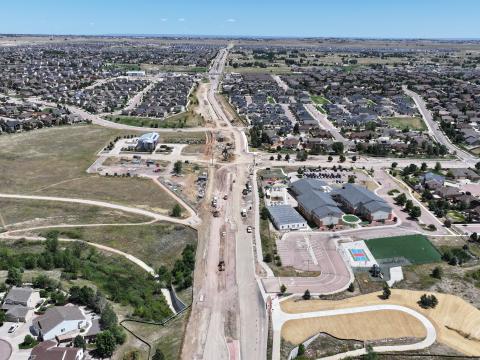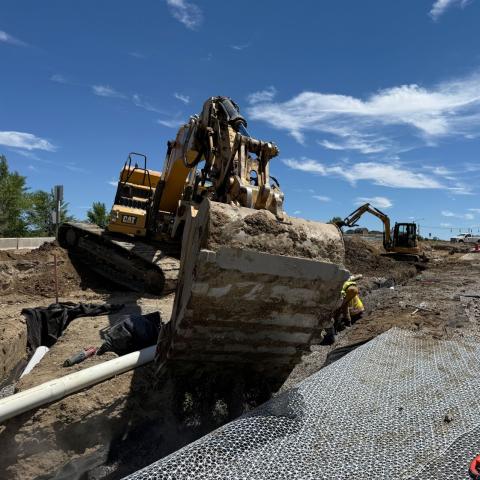Traffic Impacts
- Dublin Boulevard is open. Expect lane closures and traffic shifts.
- Issaquah Drive north of Dublin Boulevard is closed for trench and road work through early December.
- Issaquah Drive south of Dublin Boulevard will be closed from Dec. 2 through January. Business access from Dublin Boulevard is open east of Issaquah Drive. Mustang Rim Drive is open for residential and business access.
- Travelers should expect equipment and workers adjacent to the road.
- The posted work zone speed limit may be reduced to 35 mph.
- Follow signs and flagger directions when present.
- View the Construction Updates tab for more information on construction and traffic impacts.
Text DUBLIN to 866-762-3640 to receive text alerts regarding construction updates and traffic impacts.
About
Dublin Boulevard from Fieler Drive to Marksheffel Road will be improved from a two-lane road to two lanes in each direction with shoulders. A raised median will be constructed to match other sections of Dublin Boulevard. Additional improvements include a ten-foot multi-use path along both sides of the street, trail connections along Sand Creek, and a new traffic signal at Issaquah Drive. Drainage upgrades include storm sewer pipes, inlets, and water quality structures.
Project Benefits
- Enhance pedestrian access with new multi-use paths, connections and crosswalks
- Improve mobility by adding an additional lane in each direction and turn lanes at select intersections
- Change access points and remove turning movement conflicts for drivers
- Optimize safety by installing a new traffic signal at Issaquah Drive
- Address groundwater infiltration near Peterson Road
Maps
Construction Updates
This section of the page will be updated frequently during construction with newsletters and updates for Dublin Boulevard Improvements from Fieler Drive to Marksheffel Road.
- December 1, 2025 update
- November 21, 2025 update
- November 13, 2025 update
- October 23, 2025 update
- September 30, 2025 update
- September 25, 2025 update
- September 19, 2025 update
- September 8, 2025 update
- August 14, 2025 update
- August 9, 2025 update
- July 30, 2025 update
- July 11, 2025 update
- June 24, 2025 update
- June 13, 2025 update
- May 30, 2025 update
- May 23, 2025 update
- May 14, 2025 update
- May 6, 2025 update
- April 21, 2025 update
- April 9, 2025 update
- September 11, 2024 update
Open House Exhibits
Click the links below for downloadable versions of the exhibit boards displayed at the Sept. 17 open house:
- Dublin Blvd. Improvements project open house exhibit boards
- Dublin Blvd. Improvements project layout and new traffic pattern exhibit *Superseded - for reference only. View the detailed project map under Maps tab for the latest exhibit.
Frequently Asked Questions
Will this project address water on the road west of Peterson Road?
Yes. Investigations have started to determine the source. In November 2024, the City installed additional drains to temporarily address the situation through the winter until a permanent solution is installed. The City will continue to monitor and treat this location as needed.
Why does the design eliminate some of the left turns to and from Dublin Boulevard?
Right-in, right-out access changes are consistent with the concept plan from 12 years ago. These changes will increase safety and reduce congestion. Intersection spacing is important for mobility. All turn movements are available at Peterson and Issaquah intersections.
Are there plans to widen Dublin Boulevard to three lanes in each direction from Black Forest Road/Shimmering Creek Drive to Marksheffel Road?
No. Improvements planned as part of this project will meet current and future transportation needs. There are no plans to expand the width of Dublin Boulevard to more than two through lanes in each direction in this section. The traffic study completed for the Banning Lewis Ranch development shows that only four lanes are needed on Dublin Boulevard at full build out.
Recent and near-term roadway improvements will give drivers improved travel options and reduce the pressure on Dublin Boulevard. These projects include adding a third lane to Woodmen Road in both directions from Golden Sage Road to Powers Boulevard, expanding Marksheffel Road, and extending Banning Lewis Parkway to Woodmen Road.
As Banning Lewis Ranch develops over the next 20 years, new roadways and connections will be built by developers. These improvements include extending Banning Lewis Parkway to Barnes Road, extending Dublin Boulevard to US 24, and extending Barnes Road east from Marksheffel Road to Banning Lewis Parkway. The future road network will distribute Banning Lewis traffic to multiple roadways in the area.
How does this benefit pedestrians and motorists?
The project is filling in the existing gaps by adding a consistent number of travel lanes and building new sidewalks/paths. Sand Creek Trail connections will be paved.
Will there be bike lanes?
No, there will not be signed bike lanes, but multi-purpose shoulders (five feet wide, not including the concrete gutter) are available if cyclists wish to ride on the road. Bike lanes are not present on Dublin Boulevard in the areas immediately east and west of this segment. The project is constructing shared-use paths on both sides of the street.
What will the speed limit be on Dublin Boulevard once this project is complete?
The final speed limit has not been established for this stretch of Dublin Boulevard. Traffic Engineering will assign the most appropriate speed limit for the corridor. While a consistent speed limit is desirable, there are many factors that go into assigning speed limits, including the presence of school zones, number of lanes, and the distance between traffic signals. It's also possible that speed limits will be adjusted once all lanes are open in the final configuration.
How is this project funded?
The project is funded through the Pikes Peak Rural Transportation Authority (PPRTA) and the total project cost is estimated at $15 million.
Can roundabouts be installed instead of traffic signals?
The City will not be installing roundabouts with this project. Since the initial planning of Dublin Boulevard did not consider roundabouts at intersections, building them now would require additional land purchases. In addition, retrofitting an existing intersection to a roundabout tends to be more costly than if the roundabout is built as part of the original roadway network in a development.
The Marksheffel Road and Issaquah Drive intersections are about 500 feet apart, and traffic signals will be interconnected to keep vehicles from stacking into the adjacent intersection.
Progress Photos
July/August 2025 Photos





